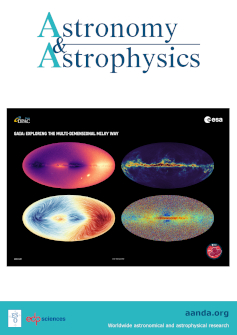ESPRESSO揭示了WASP-76 b★日面的蓝移中性铁发射线
IF 5.4
2区 物理与天体物理
Q1 ASTRONOMY & ASTROPHYSICS
引用次数: 0
摘要
背景超高温木星(Teq > 2000 K的气态巨行星)是引人入胜的系外行星,因为它们的大气中存在着极端的物理和化学成分。可以利用地面高分辨率发射光谱来描述它们的炙热天体。我们在超热木星 WASP-76 b 的日侧寻找中性铁和单质电离铁(分别为 Fe I 和 Fe II)的特征,因为在这颗系外行星中通过透射光谱探测到了这些物种。此外,我们的目的是证实之前研究中报道的热反转层的存在,并尝试对其特性进行约束。我们利用 VLT 的 ESPRESSO 对 WASP-76 b 进行了四次观测,分别是在二次凌日前不久和凌日后不久的轨道阶段,当时日面在观测范围内。我们首次分析了这颗系外行星的高分辨率光学发射光谱。我们利用交叉相关函数技术,将数据与用 petitRADTRANS 创建的合成模板进行了比较。我们在 WASP-76 b 的日侧 6.0σ 处探测到一个蓝移(-4.7 ± 0.3 km s-1)的 Fe I 发射信号。该信号在日食之前和之后都被探测到,而且都是蓝移。铁发射特征的存在证实了热反转层的存在。铁 II 没有被探测到,可能是因为这种物质位于大气的上层,光学厚度较薄。因此,WASP-76 b日侧的铁II特征太弱,无法用发射光谱探测到。我们认为蓝移铁一特征是由从热点上升到大气上层的物质产生的,并讨论了与热点位置有关的可能情况。这项工作通过分析超热木星 WASP-76 b 大气层中的铁离子特征,揭示了其日侧正在发生的一些动态过程,并补充了之前从透射研究中获得的知识。它还凸显了ESPRESSO探测这类系外行星日侧的能力。本文章由计算机程序翻译,如有差异,请以英文原文为准。
ESPRESSO reveals blueshifted neutral iron emission lines on the dayside of WASP-76 b★
Context. Ultra hot Jupiters (gas giants with Teq > 2000 K) are intriguing exoplanets due to the extreme physics and chemistry present in their atmospheres. Their torrid daysides can be characterised using ground-based high-resolution emission spectroscopy.Aims. We search for signatures of neutral and singly ionised iron (Fe I and Fe II, respectively) in the dayside of the ultra hot Jupiter WASP-76 b, as these species were detected via transmission spectroscopy in this exoplanet. Furthermore, we aim to confirm the existence of a thermal inversion layer, which has been reported in previous studies, and attempt to constrain its properties.Methods. We observed WASP-76 b on four epochs with ESPRESSO at the VLT, at orbital phases shortly before and after the secondary transit, when the dayside is in view. We present the first analysis of high-resolution optical emission spectra for this exoplanet. We compare the data to synthetic templates created with petitRADTRANS, using cross-correlation function techniques.Results. We detect a blueshifted (−4.7 ± 0.3 km s−1) Fe I emission signature on the dayside of WASP-76 b at 6.0σ. The signal is detected independently both before and after the eclipse, and it is blueshifted in both cases. The presence of iron emission features confirms the existence of a thermal inversion layer. Fe II was not detected, possibly because this species is located in the upper layers of the atmosphere, which are more optically thin. Thus the Fe II signature on the dayside of WASP-76 b is too weak to be detected with emission spectroscopy.Conclusions. We propose that the blueshifted Fe I signature is created by material rising from the hot spot to the upper layers of the atmosphere, and discuss possible scenarios related to the position of the hotspot. This work unveils some of the dynamic processes ongoing on the dayside of the ultra hot Jupiter WASP-76 b through the analysis of the Fe I signature from its atmosphere, and complements previous knowledge obtained from transmission studies. It also highlights the ability of ESPRESSO to probe the dayside of this class of exoplanets.
求助全文
通过发布文献求助,成功后即可免费获取论文全文。
去求助
来源期刊

Astronomy & Astrophysics
地学天文-天文与天体物理
CiteScore
10.20
自引率
27.70%
发文量
2105
审稿时长
1-2 weeks
期刊介绍:
Astronomy & Astrophysics is an international Journal that publishes papers on all aspects of astronomy and astrophysics (theoretical, observational, and instrumental) independently of the techniques used to obtain the results.
 求助内容:
求助内容: 应助结果提醒方式:
应助结果提醒方式:


